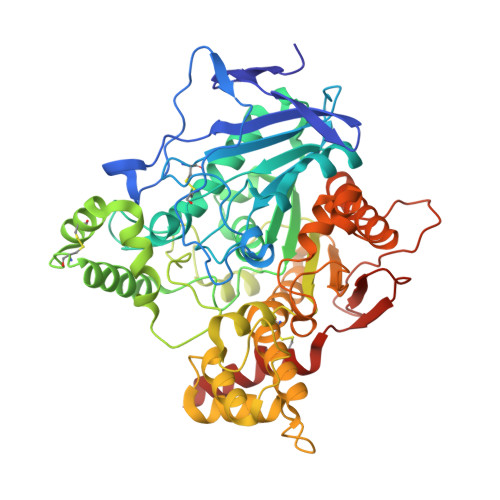A conformational change in the peripheral anionic site of Torpedo californica acetylcholinesterase induced by a bis-imidazolium oxime.
Legler, P.M., Soojhawon, I., Millard, C.B.(2015) Acta Crystallogr D Biol Crystallogr 71: 1788-1798
- PubMed: 26327369
- DOI: https://doi.org/10.1107/S1399004715011281
- Primary Citation of Related Structures:
5BWB, 5BWC - PubMed Abstract:
As part of ongoing efforts to design improved nerve agent antidotes, two X-ray crystal structures of Torpedo californica acetylcholinesterase (TcAChE) bound to the bis-pyridinium oxime, Ortho-7, or its experimental bis-imidazolium analogue, 2BIM-7, were determined. Bis-oximes contain two oxime groups connected by a hydrophobic linker. One oxime group of Ortho-7 binds at the entrance to the active-site gorge near Trp279, and the second binds at the bottom near Trp84 and Phe330. In the Ortho-7-TcAChE complex the oxime at the bottom of the gorge was directed towards the nucleophilic Ser200. In contrast, the oxime group of 2BIM-7 was rotated away from Ser200 and the oxime at the entrance induced a significant conformational change in the peripheral anionic site (PAS) residue Trp279. The conformational change alters the surface of the PAS and positions the imidazolium oxime of 2BIM-7 further from Ser200. The relatively weaker binding and poorer reactivation of VX-inhibited, tabun-inhibited or sarin-inhibited human acetylcholinesterase by 2BIM-7 compared with Ortho-7 may in part be owing to the unproductively bound states caught in crystallo. Overall, the reactivation efficiency of 2BIM-7 was comparable to that of 2-pyridine aldoxime methyl chloride (2-PAM), but unlike 2-PAM the bis-imidazolium oxime lacks a fixed charge, which may affect its membrane permeability.
- CBMSE, U.S. Naval Research Laboratory, 4555 Overlook Avenue, Washington, DC 20375, USA.
Organizational Affiliation:


















